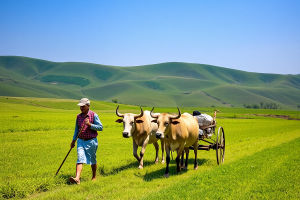Time is flying these days. We are already in the third week since the Orthodox Lent fasting season has started, and in the second week of Ramadan, since the month-long Muslim fasting time has announced itself suddenly. One of the most interesting times of the beginning of the fasting season probably comes on the day before or on the eve. This is probably the most hectic time for many of us who, for one reason or another, might have lost the festivities, the dinners, and the happiness of the eve. The day before the start of the big fasting season is a big day of big eating and big drinking.
While speaking of Islamic and orthodox fasting, we cannot avoid having a brief look at the history of the two biggest religions in the country. Islam has not only a very long history in Ethiopia. It is also an important or indispensable part of Ethiopian history. Ethiopian history cannot be complete without its Islamic component both at the national and grassroots levels because the country’s culture, arts, traditions, belief systems and practices are closely linked to Islam itself. It is therefore difficult if not impossible to imagine Ethiopia without Islam. This can also be seen from the size of the Islamic population, which, in 2024, was 31.5% of the country’s population or around 37.2 million people.
Islam is the second most practiced religion in Ethiopia after Christianity. The two religions have coexisted peacefully for a long time. Islam arrived in Ethiopia 615 when the prophet Mohamed advised his followers to seek refuge in the Kingdom of Aksum which was ruled by a man called Negashi, a Christian king who offered protection for the refugees. The first Muslim Hijra or pilgrimage also took place in Aksum. The eastern Ethiopian city of Harar is considered the fourth holiest city of Islam and is home to many mosques and shrines.
There are many things that are unique to Ethiopian culture, and among them are the cultures of religious practices and beliefs, as well as their rituals. Ramadan is the month in which it is believed that the Holy Qur’an was sent down from the heavens. as a guidance for men and women, a declaration of direction and a means of salvation. During the month, Muslims observe a strict fast from dawn until sunset.
There were also official prejudices that tarnished relations between or among people adhering to different religious denominations. Religious consciousness was relatively low and faith had not yet interfered in the political and social discourse. In the last half a century or so, and after the 1974 revolution in particular, religion in Ethiopia started to occupy the national center stage. The revolution, as we remember it, was a godless, or an atheist movement whereby the material world was considered primary and spirit or consciousness secondary, as the Marxists taught us. In present terms, this amounts to saying that the divine came into being after the material world was created.
It was a long fact that Orthodox Christianity in Ethiopia was the religion of both the palace and the people. Ethiopian history is largely related to the history of the church which was considered a third estate in accordance with its wealth and political influence. Its influence started to diminish only after the revolution as priests and church dignitaries were considered part of the “reactionary or oppressive” class in society. Church properties were confiscated, and the clergy were divided between those who supported the revolution and those who remained neutral or opposed it. Religion was largely politicized although society was looking at the process with relative calm and detachment.
It is obvious that orthodox Christianity had dominated religious life in Ethiopia for many centuries, while Islam as a non-state religion was at a disadvantage in the political, economic, social and cultural realities of the time. There was also a time when Muslims were alienated from national life due to distortions and prejudices that marked the role of Islam in the history and culture of the country. It is to be recalled that Muslims did not readily accept the official narratives of the time and preferred to advance their own versions of events regarding the role and place of Islamic societies in the life of the nation.
The Ethiopian revolution of 1974 had no doubt a positive effect on the history of Islamic political consciousness. For the first time in their long existence, Muslims in Ethiopia and in the capital Addis Ababa in particular staged the biggest rally or demonstration ever, demanding religious equality and joined the democratic movement that was taking shape at that time. February 1974 was indeed a turning point in the emancipation of Muslims who came together with their Christian brothers and sisters to articulate their aspirations for freedom, equality and emancipation from the direct and indirect domination of the monarchy.
Since then, the quest for freedom and religious equality by Muslims in Ethiopia grew by leaps and bounds, leading to the official recognition of Muslims as equal partners in national life with their rights respected and enshrined in the country’s constitution. The participation of Muslims in national politics is nowadays constitutionally guaranteed and practically implemented and relations between the two major religions are characterized by harmony, mutual understanding, and mutual respect. The majority of Ethiopian Muslims follow what is known as the Sunni brand or sect of Islam, which is relatively more tolerant and peaceful, which also contributes to the peaceful coexistence between Islam and Christianity in the country.
Contrary to many countries, both Christianity and Islam have remained at their core religions of the broad masses of the people whose daily lives are directly shaped or determined by their faiths. Both Christianity and Islam in Ethiopia are peaceful faiths as far as grassroots relations are concerned while there were also a few instances of upheavals. How did Christianity and Islam expand? “Christianity, originating in Judea, spread via missionary efforts initially within the Roman empire, then globally while Islam, emerging in the Arabian Peninsula, expanded rapidly through conquest and trade, eventually encompassing vast regions from Africa to Southeast Asia.”
How did Islam and Christianity spread in Africa? “The early Christian Coptic Church was the first form of institutionalized Christianity on the African continent. Islamization of West and East Africa followed trade routes, presenting its language and culture as a useful lingua franca among merchants from diverse ethnic groups.”
Christianity was born from within the Jewish tradition, and Islam developed from both Christianity and Judaism. While there have been differences among these religions, there was a rich cultural interchange between Jews, Christians and Muslims that took place in Islamic Spain and other places over centuries.”
Muslims and Christians lived together in peace for many centuries, although there were brief periods of crises in relations between the adherents of the two religions. While admitting the fact that a Muslim-Christian relation was not always smooth, we should also emphasize on the fact that the misunderstandings or conflicts were not caused by grassroots adherents of the two faiths. They were rather instigated by individuals who were keen to spread the faiths by force or gain territories for their followers.
Muslims and Christians in Ethiopia not only have a common history but also share a common tradition and culture as reflected in the time and how they observed one of the most important traditions, namely the ritual of fasting. Adherents of both faiths celebrate fasting in accordance with their respective history, culture, traditions and rituals. “In Orthodox Christian tradition, fasting involves abstaining from certain foods and behaviors as a practice of repentance, spiritual discipline and communal observance during specific periods throughout the year, including weekly Wednesdays and Fridays.”
Why do Christian and Islamic fasting seasons coincide every year? That may be due to sheer coincidence rather than fate. This may sound strange because we never paid attention to the timing of the two fasting periods. In the past, everyone minded about their particular religious beliefs and the ways they observed fasting and did not care about what the other guy in that other faith was doing. There was also an unofficial or unwritten law that said, the country is our common abode while religion was a private affair.
Nowadays the notion and practice of fasting is increasingly assuming new dimensions that some people call “modern”. It is possible to modernize religion without ignoring its basic tenets or its core teachings. When it comes to fasting, modernity seems to be related to the changes in attitude and practice of fasting, particularly among the new generations who have already embraced fasting as part of a healthier lifestyle.
Intermittent fasting for instance has entered the health and lifestyle lexicon a rather long time ago; although religious fasting is not something easy to do as it entails devotion, strong faith, patience as well as endurance. Adherents of both religions are still in the early phase of their fasting seasons. Can we wish them, “happy fasting”? Why not? For most of the adherents of the two religions, fasting is indeed one of the happiest moments of their lives because it is done with love and selflessness.
BY MULUGETA GUDETA
THE ETHIOPIAN HERALD THURSDAY 20 MARCH 2025


